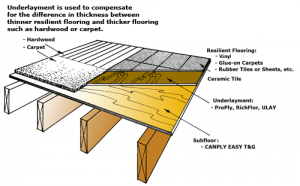 What is a sub-floor?
What is a sub-floor?
Your sub-floor is what lies beneath your current flooring (carpet, tile, linoleum, hardwood flooring) throughout your home. There are several options, the most common are wood (or plywood), and concrete (prevalent in wetter climates, so not usually seen here in Northern Nevada).
Why does my sub-floor matter?
Depending on your sub-floor type, and your new flooring type, your installation options vary. For concrete, your best bet is either a glue-down or a free-floating install. For plywood, you have more options since nail-down and staple-down are also viable.
How do I choose an installation method?
Ultimately, the combination of sub-floor, chosen hardwood flooring type (engineered floors include: plank, strip hardwood, and parquet wood flooring; natural floor would include: solid hard wood flooring), and your experience level (if you are a DIYer) or that of your installer, will narrow down your options for installation methods.
What is the difference between installation methods?
Nail down – is not DIY friendly and works on plywood sub-flooring only. This method is used mostly for solid wood flooring as it is thicker and will expand and contract more than thinner flooring types (which makes gluing an issue).
Staple down – can be DIY friendly (there are some special tools you may need to rent or buy), and works on plywood sub-flooring only. This method is used mostly for engineered flooring types and it is important to find out the size of staples recommended for your new flooring type before you begin.
Glue Down – can be DIY friendly and is especially good for concrete, but works well on plywood sub-flooring also. This method is used for engineered flooring types and is very stable if done correctly. It can also eliminate creaking as there are no metal fasteners in place. (Sub-floor prepping is extremely important in this specific installation type, so tune in next month for more on prepping your sub-floor to avoid problems down the line and ensure the long term results you expect).
Free-float – is very DIY friendly and works for either sub-floor type. This installation type has been growing in popularity due to how easy it is for a DIYer to install. This method is used generally for large panels of engineered wood flooring or the growing popularity of ‘click-together’ type flooring, this type of installation allows for easy expansion and contraction of the wood and reduces creaking since it is not attached to the subfloor and has a foam underlayment.
If you are looking into installing your new hardwood flooring yourself, there are several sources of information on YouTube where there are videos that can help you through the process. Remember though, there are no guarantees on a job you do yourself, so if you are worried about your level of experience, don’t hesitate to call in the experts! We are always available to meet with you and discuss your options – call me, Sorin, today at 775-830-4243.
